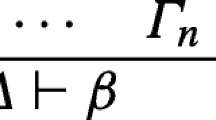Abstract
This paper is devoted to the concepts of consequence and rejection, formulated as operators on a nonempty set of sentences, which may initially be unstructured. One of the issues that we pay attention to is the “cyclicity” of these concepts when they are defined one through the other. In addition, we explore this cyclicity, when the set of all sentences acquires some structure, or we can assume some structure of sentences in the sense that the operation of substitution can be applied to them.
Similar content being viewed by others
Notes
Another feature of \({\mathcal {S}}\), which is of no importance to us here, was the limitation of the cardinality of \({\mathcal {S}}\); namely, Tarski considered \(\overline{\overline{{\mathcal {S}}}}\le \aleph _0\) by definition.
The only exception I know of is [3].
At least definition DCn\(^+\) offers this rationale, because as soon as Cn\(^+\) is defined, its relation to \({\textbf{C}}{}\) immediately arises. What happens if recovery does not occur will be discussed at the end of Sect. 4.
See Remark 3.6 about the differences between Cn\(^+\) and \(\textbf{C}_{\textbf{R}_{\textbf{C}}}\).
In a way, this is similar to Carnap’s rule (2) from [2], §26, definition D26-6.
This is the minimum condition that can be imposed on \({\textbf{C}}{}\).
I am indebted to Alex Citkin, who drew my attention to this issue. His point of view is categorical: the rejection operator must not be structural (see definition below).
As Wójcicki believed, calling the consequence structural and logical in a synonymous way; in his own words,
[\(\ldots \)] a logic of formulas is not just a set of formulas closed under substitutions but the set of all ‘logically true’ formulas, a logic of inferences is not just a structural consequence operation (or the set of inferences sound for it) but the set of all ‘logically valid’ inferences ([10], p. 45).
References
Bednarowski, W.: Review: Jerzy Słupecki, The Łukasiewicz function. J. Symb. Logic 32(4), 536 (1967)
Carnap, R.: Introduction to Semantics. Harvard University Press, Cambridge, Mass. (1942)
Citkin, A.: Unified deductive systems: an outline. (2023). Manuscript
Citkin, A., Muravitsky, A.: Consequence Relations, volume 55 of Oxford Logic Guides. Oxford University Press, New York, (2022). Oxford Science Publications
Słupecki, J.: Funkcja Łukasiewicza (Łukasiewicz’s function). Zeszyty Naukowe Uniwersytetu Wrocławskiego Matematyka, Fizyka, Astronomia 11, 33–40 (1959)
Słupecki, J., Bryll, G., Wybraniec-Skardowska, U.: Theory of rejected propositions. I. Studia Logica 29, 75–123 (1971)
Spasowski, M.: Some connections between \(Cn\), \(Cn^{-1}\) and \(dCn\). Polish Acad. Sci. Inst. Philos. Sociol. Bull. Sect. Logic 2(1), 46–50 (1973)
Tarski, A.: Logic, Semantics, Metamathematics. Hackett Publishing Co., Indianapolis, IN, 2nd edn, 1983. Papers from 1923 to (1938). Translated by J. H. Woodger, Edited and with an introduction by John Corcoran
Wójcicki, R.: Dual counterparts of consequence operations. Polish Acad. Sci. Inst. Philos. Sociol. Bull. Sect. Logic 2(1), 54–57 (1973)
Wójcicki, : Theory of Logical Calculi, volume 199 of Synthese Library. Kluwer Academic Publishers Group, Dordrecht, (1988). Basic theory of consequence operations
Wybraniec-Skardowska, U.: Teoria zdań odrzuconych. In: Z Badań Nad Teoria ZdańOdrzuconych, number 22 in Seria B: Monografie, pages 5–131. Zeszyty Naukowe Wyższej Szkoły Pedagogicznej w Opolu, (1968)
Wybraniec-Skardowska, U.: On the mutual definability of the notions of entailment, rejection, and inconsistency. Axioms 5(15), 19 (2016)
Author information
Authors and Affiliations
Corresponding author
Additional information
Publisher's Note
Springer Nature remains neutral with regard to jurisdictional claims in published maps and institutional affiliations.
Rights and permissions
Springer Nature or its licensor (e.g. a society or other partner) holds exclusive rights to this article under a publishing agreement with the author(s) or other rightsholder(s); author self-archiving of the accepted manuscript version of this article is solely governed by the terms of such publishing agreement and applicable law.
About this article
Cite this article
Muravitsky, A. On Consequence and Rejection as Operators. Log. Univers. 17, 443–460 (2023). https://doi.org/10.1007/s11787-023-00334-y
Received:
Accepted:
Published:
Issue Date:
DOI: https://doi.org/10.1007/s11787-023-00334-y




